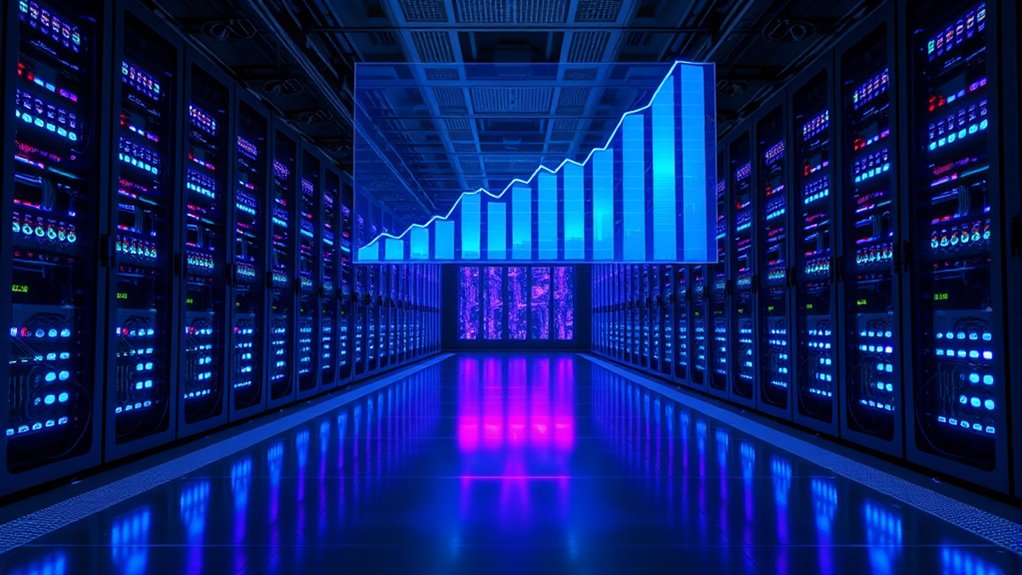Multi-billion dollar AI infrastructure deals are reshaping the industry, as companies invest heavily in expanding data centers, upgrading hardware, and embracing edge computing. These investments improve processing speed, reduce latency, and support advanced AI applications across sectors like healthcare and finance. Cloud collaborations are also growing, creating scalable, secure environments for future innovations. If you want to understand how these massive deals impact the tech landscape and what’s next, there’s more to uncover.
Key Takeaways
- Massive investments are fueling AI infrastructure expansion, focusing on scalable data centers and edge computing solutions.
- Companies are shifting from centralized data centers to hybrid models that incorporate edge computing for faster processing.
- Upgrades in hardware and cooling systems are essential to support high-density AI workloads and optimize energy efficiency.
- Cloud providers are partnering with firms to expand infrastructure, enabling lower latency and improved AI performance globally.
- Security and compliance measures are prioritized to protect sensitive data and support future AI innovations.

As artificial intelligence continues to transform industries, companies are racing to secure the necessary infrastructure to support these advanced technologies. The landscape is dominated by massive deals aimed at expanding and upgrading AI infrastructure, making it clear that the market recognizes the critical role of robust, scalable systems. Among the most significant trends is the emphasis on edge computing, which brings processing power closer to data sources, reducing latency and improving real-time decision-making. This shift means that organizations no longer rely solely on centralized data centers but are investing heavily in edge solutions to handle the vast influx of data generated by AI applications.
Edge computing accelerates AI by reducing latency and enabling real-time decision-making beyond traditional data centers
In these multi-billion-dollar deals, data center optimization plays a vital role. Leading companies are pouring capital into upgrading existing facilities and building new, highly efficient data centers tailored for AI workloads. These data centers are designed to handle enormous computational demands while minimizing energy consumption and operational costs. This optimization extends beyond hardware to include advanced cooling systems, intelligent power management, and automation, ensuring maximum performance with minimal waste. You can see that such investments are crucial because AI workloads require specialized hardware like GPUs and TPUs, which demand an environment that facilitates high density and thermal management. Additionally, implementing diversified investments can help mitigate risks associated with rapidly evolving AI infrastructure needs.
Furthermore, these deals often involve partnerships with global cloud providers, who are racing to offer AI-ready infrastructure at scale. Cloud giants are expanding their data center footprints, integrating edge computing nodes to facilitate faster data processing and lower latency for end-users. This means you, as a user or developer, will benefit from more responsive AI services, whether you’re deploying models in healthcare, finance, or autonomous vehicles. The focus on data center optimization ensures that these vast infrastructures are not just large but also efficient, scalable, and capable of supporting future AI innovations.
The strategic investments in AI infrastructure are also driven by the need for security and compliance. As data centers become more complex, companies are investing in state-of-the-art security measures to protect sensitive data and meet regulatory standards. This, combined with edge computing deployment, enables real-time data analysis with enhanced privacy controls, which is increasingly important in sectors like healthcare and finance.
Frequently Asked Questions
How Do These Deals Impact Global AI Innovation?
These multi-billion AI infrastructure deals boost global AI innovation by enhancing AI scalability, allowing you to develop more advanced, efficient solutions. They also intensify market competition, pushing you to innovate faster and stay ahead. As companies invest heavily, you benefit from cutting-edge technology and increased collaboration. This dynamic environment accelerates AI progress worldwide, making it easier for you to access powerful tools and contribute to groundbreaking advancements.
What Are the Environmental Implications of Large AI Infrastructure Projects?
You should consider that large AI infrastructure projects critically increase your carbon footprint due to high energy consumption. They also demand vast resource consumption for hardware, cooling, and maintenance, which can strain local ecosystems. This environmental impact prompts you to explore sustainable practices, like renewable energy use and efficient design, to reduce negative effects. Balancing AI growth with environmental responsibility becomes essential for your long-term success and global sustainability.
Who Are the Key Players Driving These Multi-Billion Dollar Deals?
You see major players like tech giants, cloud providers, and AI startups driving these multi-billion dollar deals. They invest heavily in AI startup ecosystems and data center infrastructure to stay competitive. Companies like Google, Microsoft, and Amazon lead the charge, partnering with innovative startups to expand capabilities. Their focus is on building scalable, efficient AI infrastructure, ensuring they dominate the evolving market and meet increasing demand for advanced AI solutions.
How Do These Investments Influence AI Talent Distribution Worldwide?
These investments drive talent migration, attracting AI experts to regions with advanced infrastructure. You’ll notice regional disparities widen as countries with heavy investments become talent hubs, pulling skilled professionals from less developed areas. This shift intensifies competition for top talent, leaving some regions behind. As a result, you’ll see a concentration of AI innovation in certain locations, making it harder for emerging markets to catch up in the global AI landscape.
What Regulatory Challenges Accompany Massive AI Infrastructure Investments?
Ever wonder how huge AI investments face hurdles? You must consider data privacy and infrastructure security challenges. Regulators scrutinize these investments to protect sensitive data and ensure systems aren’t vulnerable to cyber threats. You’ll need to navigate varying international laws, address compliance issues, and implement strong security measures. These hurdles can slow down deployment, increase costs, and require ongoing oversight, making regulatory challenges a vital part of expanding AI infrastructure.
Conclusion
You’re witnessing a revolution so massive, it’ll redefine the entire tech universe! These multi-billion AI infrastructure deals aren’t just big—they’re colossal, game-changing moves that will reshape industries overnight. As billions flow into building the most advanced AI ecosystems, you can expect a future where AI dominates every aspect of your life, faster and smarter than you ever imagined. Get ready—you’re on the brink of witnessing history in the making, and it’s only just beginning!









